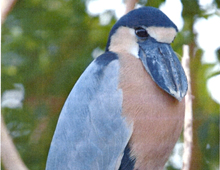Description: Boat-billed herons are named for their massive, dark, scoop-like bill. Adults and juveniles differ in appearance. Adults have a black head with a long bushy crest and huge dark eyes. They have a white forehead and throat; black flanks; rufous underparts; and pale gray wings and lower back. Juvenile birds do not have a crest and are brown above and brown-tinged whitish below.
Size: Adults are about 21.5 inches (55 cm) long and weigh approximately 21 ounces (595 gr).
Behavior: During the day, they roost in large groups up to 50 birds, but at night they are solitary. At dusk and early night, these nocturnal birds forage for food along the water’s edge using the “standing still” method of feeding. They use their large bill to scoop up food.
Diet: They feed on fish, crustaceans, insects and small amphibians.
Senses: They have a good sense of sight. It is also believed by some experts, that Boat-billed herons rely on touch to catch their prey.
Communication: Their calls include a high- pitched “pee-pee-pee” and deep croaks. They also use bill-pops which sound like hand- clapping.
Reproduction: Nesting is done semi-colonially or in pairs in a twig nest that is built in trees, bushes or reed beds. Two to four bluish white eggs are laid and incubated for a period of 25-27 days by both parents.
Habitat/range: Boat-billed herons are found on the margins of freshwater rivers, lakes, marshes and in mangrove swamps from Mexico down through Central and South America, as far south as Peru and Brazil.
Status: Listed as Least Concern on IUCN Red List.



